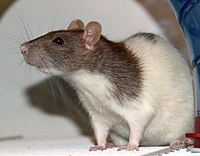
Photo from wikipedia
Seoul virus (SEOV), which is predominantly carried by Rattus norvegicus, is one of the major causes of hemorrhagic fever with renal syndrome (HFRS) in China. Hubei province, located in the… Click to show full abstract
Seoul virus (SEOV), which is predominantly carried by Rattus norvegicus, is one of the major causes of hemorrhagic fever with renal syndrome (HFRS) in China. Hubei province, located in the central south of China, has experienced some of the most severe epidemics of HFRS. To investigate the mitochondrial DNA (mtDNA)-based phylogenetics of wild rats in Hubei, and the relationship with SEOV infection, 664 wild rats were captured from five trapping sites in Hubei from 2000–2009 and 2014–2015. Using reverse-transcription (RT)-PCR, 41 (6.17%) rats were found to be positive for SEOV infection. The SEOV-positive percentage in Yichang was significantly lower than that in other areas. The mtDNA D-loop and cytochrome b (cyt-b) genes of 103 rats were sequenced. Among these animals, 37 were SEOV-positive. The reconstruction of the phylogenetic relationship (based on the complete D-loop and cyt-b sequences) allowed the rats to be categorized into two lineages, R. norvegicus and Rattus nitidus, with the former including the majority of the rats. For both the D-loop and cyt-b genes, 18 haplotypes were identified. The geographic distributions of the different haplotypes were significantly different. There were no significant differences in the SEOVpositive percentages between different haplotypes. There were three sub-lineages for the D-loop, and two for cyt-b. The SEOV-positive percentages for each of the sub-lineages did not significantly differ. This indicates that the SEOV-positive percentage is not related to the mtDNA D-loop or cyt-b haplotype or the sub-lineage of rats from Hubei.
Journal Title: Virologica Sinica
Year Published: 2017
Link to full text (if available)
Share on Social Media: Sign Up to like & get
recommendations!